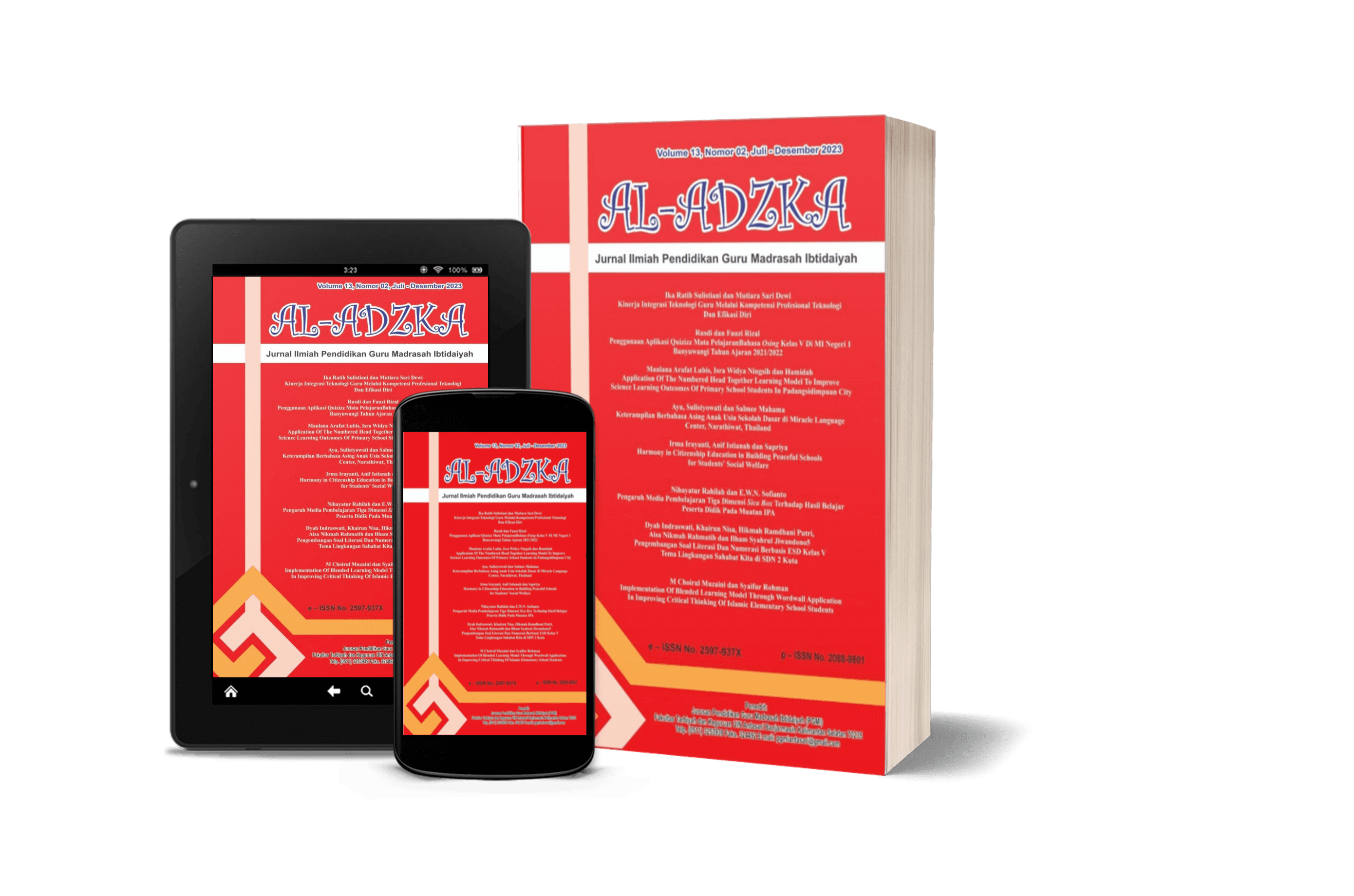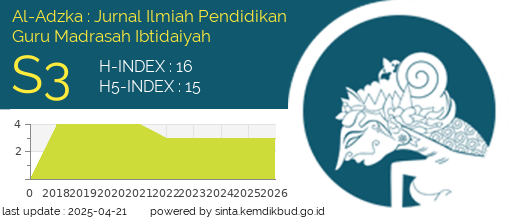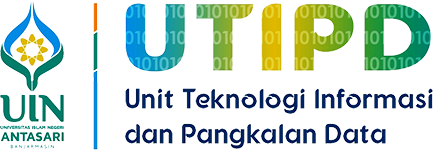The Relationship between Learning Activeness and Student Learning Outcomes in Al-Qur'an Hadith Subject
DOI:
https://doi.org/10.18592/aladzkapgmi.v12i2.7713Keywords:
learning activity, learning outcomes, Al-Qur’an HaditsAbstract
This study aims to determine whether there is a relationship between active learning and student learning outcomes in Al-Qur'an Hadith subject at MIS Al-Ashriyah Banjarmasin. This study uses a correlation research type with a quantitative approach. Data collection using observation sheets, interviews, questionnaires and documentation. Processing data using statistical analysis correlation test to determine the relationship between two variables and determine the correlation coefficient. Based on data processing with the help of SPSS version 26, a correlation coefficient of 0.588 was obtained with the number N = 37 at the 5% level of 0.325. The result showed that 0.588 > 0.325 or value of r-count more than r-table. It shows a correlation or relationship with the medium category between learning activity and student learning outcomes in Al-Qur'an Hadith subject MIS Al-Ashriyah Banjarmasin. This research hopes to spur enthusiasm to increase active learning to achieve the best learning results.References
Duwi Priyatno, D. P. (2010). Paham Analisa Statistik Data dengan SPSS. Buku Seru.
Fa’atin, S. (2017). Pembelajaran Qur’an Hadits Di Madrasah Ibtidaiyah Dengan Pendekatan Integratif Multidisipliner. Elementary, 5(2), 397.
Hamalik, O. (2015). Kurikulum dan Pembelajaran (S. Grafika, Ed.).
Honggowiyono, P. (2015). Pertumbuhan dan Perkembangan Peserta Didik untuik Guru dan Calon Guru. Gunung Samudera.
Khon, A. M. (2011). Praktikum Qiraat. Amzah.
Kurniawati, Y., Ngadimin, & Farhan, A. (2017). Hubungan Keaktifan Siswa Dengan Hasil Belajar Siswa Padapenerapan Model Pembelajarangroup Investigation. Jurnal Ilmiah Mahasiswa (JIM) Pendidikan Fisika, Vol.2(No.2), 243–246.
Maslianiwati, M. (2018). Peningkatan Hasil Belajar Peserta Didik dengan Metode Cerita Bergambar pada Materi Benda Hidup dan Tak Hidup Kelas 1 MIN 9 Banjar. Journal of Al-Adzka: Jurnal Ilmiah Pendidikan Guru Madrasah Ibtidaiyah, 8(2), 141. https://doi.org/10.18592/aladzkapgmi.v8i2.2363
Mulyasa. (2009). Manajemen Berbasis Sekolah. Remaja Rosdakarya.
Najiah, A., Handayani, Y., & Sholeh, M. (2022). Analysis of Teacher’s Efforts in Improving Students’ Calistung (Read-Write- Arithmetic) Skills During the Transition Period Analisis. Al-Mudarris, 5(1), 45–54. https://doi.org/10.32478/al-mudarris.v
Nana Sudjana. (2010). Dasar-Dasar Proses Belajar Mengajar. Sinar Baru.
Rahmawati, L., & Sholeh, M. (2021). Classroom Management In Creating Effective Learning In MIS Al-Ashriyah Banjarmasin. Al-Adzka: Jurnal Ilmiah Pendidikan Guru Madrasah Ibtidaiyah, 11(2), 76–85. https://doi.org/10.18952/aladzkapgmi.v11i2.4644
Sari. (2018). Pembelajaran Visual, Auditory dan Kinestetik Terhadap Keaktifan dan Pemahaman Konsep Matematika Siswa Sekolah Dasar Nuhyal Ulia. Jurnal Pendidikan Guru MI, 5.
Savriani, E. (2020). Pengaruh keaktifan belajar terhadap hasil belajar Siswa Mata Pelajaran Matematika SDN 6 Metro Barat Tahun Pelajaran 2019/2020. IAIN Metro.
Sholeh, M. (2017). Perbandingan Prestasi Belajar Menggunakan Strategi Paikem dengan Model Gallery Walk Pada Mata Pelajaran Sejarah Kebudayaan Islam Kelas V di MI Siti Mariam Dengan MI Darut Taqwa Banjarmasin. Tarbiyah Islamiyah: Jurnal Ilmiah Pendidikan Agama Islam, 7(2).
Sholeh, M. (2019). Korelasi Penggunaan Internet Sebagai Sumber Belajar dan Kemandirian Belajar Terhadap Keterlibatan Mahasiswa Dalam Proses Pembelajaran di UIN Antasari Banjarmasin. JALIE; Journal of Applied Linguistics and Islamic Education, 03(1), 138–164.
Sholeh, M., Jannah, R., Mahmudah, & Khairunnisa. (2021). Pengembangan Model Pembelajaran Efektif dan Bermakna di MI Perwanida Blitar. Muallimuna : Jurnal Madrasah Ibtidaiyah, 3(2), 116–127. http://dx.doi.org/10.31602/muallimuna.v6i2.4301
Sihaloho, I. M., & Azainil, A. (2021). Pengaruh Keaktifan dan Minat Belajar Siswa terhadap Hasil Belajar Matematika. Prosiding Seminar Nasional Pendidikan Matematika Universitas Mulawarman, 1, 33–42.
Sugiyono. (2013). Metode Penelitian Kuantitatif, Kualitatif dan R&D. Alfa Beta.
Tony Wijaya, T. W. (2013). Analisis Data Penelitian Menggunakan SPSS. Universitas Atma Jaya Yogyakarta.
Ula, S. (2013). Revolusi Belajar. Ar-Ruzz Media.
Downloads
Published
How to Cite
Issue
Section
License
Authors who publish with this journal agree to the following terms:
- Authors retain copyright and grant the journal right of first publication with the work simultaneously licensed under a Creative Commons Attribution 4.0 International that allows others to share the work with an acknowledgement of the work's authorship and initial publication in this journal.
- Authors are able to enter into separate, additional contractual arrangements for the non-exclusive distribution of the journal's published version of the work (e.g., post it to an institutional repository or publish it in a book), with an acknowledgement of its initial publication in this journal.
- Authors are permitted and encouraged to post their work online (e.g., in institutional repositories or on their website) prior to and during the submission process, as it can lead to productive exchanges, as well as earlier and greater citation of published work.












